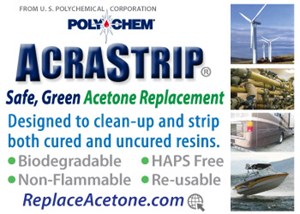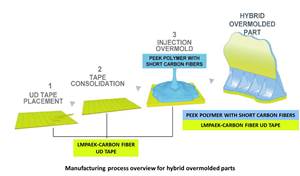Autocomposites and the myth of $5/lb carbon fiber
The $5/lb line in the sand comes with a similar challenge that, ultimately, will determine the fate of carbon fiber in automotive: Manufacturability.
When I started this job in September 2006, one of the first “composites truths” handed down to me from on high was this: Carbon fiber will not be applied to high-volume automotive structures until and unless the unit cost of said carbon fiber drops to or below US$5/lb. And if you ask any 10 composites industry veterans what the origin of this “truth” was, you will almost certainly get 10 different answers, ranging from the plausible — “Ford Motor Co. said it in a meeting with material suppliers in 1988” — to the fantastic — “It was Richard Nixon’s deathbed proclamation.” (OK, I made that second one up, but you get the point.)
Anyhow, regardless of the genesis of this statement, it has been repeated so frequently in the ensuing years that it has assumed the veneer and polish of fact, often pulled out and pointed to by automotive OEMs whenever the composites industry gets to feeling a little uppity about making automotive inroads. And then we are politely reminded of our place in the materials food chain: “Now remember, little fella,” say the OEMs, “we’re used to affordable steel. We can’t use none of that new-fangled carbon fiber unless it’s super-cheap! But if you get the price down to $5/lb — oh boy! at would be something! Now run along ....”
And then, a funny thing happened: Carbon fiber got cheaper. How cheap? It’s hard to say. Carbon fiber manufacturers don’t publish their prices, but some casual inquiries revealed that 50K tow, industrial-grade carbon fiber can be acquired from one or more suppliers for as little as $7-$8/lb (€15.4-€17.6/kg). This is not $5/lb (yet), but it is also not $12 or $15/lb. And given this downward trajectory, plus the ongoing research into low-cost carbon fiber at Oak Ridge National Laboratory (ORNL, Oak Ridge, TN, US), it’s not unreasonable to think that this infamous threshold might be breached soon. And then, oh boy!
Maybe.
The truth of the $5/lb truth, however, is more complex than it appears. The true truth is that even if carbon fiber were offered to automakers for $0/lb, its use in high-volume automotive structures would not be a foregone conclusion. This is because the $5/lb line in the sand comes with a similar challenge that, ultimately, will determine the fate of carbon fiber in automotive: Manufacturability.
The real Achilles heel of carbon fiber composites manufacturing is that it’s not easy — at least not easy the way metal stamping and plastic injection molding are. It’s not easy to design, not easy to simulate and not easy to manufacture. Carbon fiber composites manufacturing means coping with a far greater number of variables, each of which must be anticipated, measured and then controlled. To top it off, composites are the only materials in the world that are made at the same time as the parts they make.
This isn’t to say that it’s not getting easier, because it is. And in the automotive industry, fabrication of carbon fiber structures is focusing on molding processes that mimic legacy metalforming processes: Compression molding, injection overmolding and resin transfer molding show great promise for high-volume autocomposites manufacture, but to activate the value of that still-mythical $5/lb carbon fiber, they must meet automotive supply chain cycle time, repeatability, process control and waste requirements. And of these, the most important might be waste. Composite parts, no matter how inexpensive carbon fiber becomes, will always have a relatively large material cost burden, thus material use must be fully optimized to make carbon fiber viable.
So, the real question for automotive OEMs is not, How cheap do you want your carbon fiber to be? Rather, the question is, What is your cost target per kilogram of part weight? I await the answer from on high — or you. Email me at jeff@compositesworld.com with your “true” number.
Related Content
INN-PAEK project succeeds in 100% recyclable turbine
European project replaces complex-shaped metal structure in aircraft cooling system with injection molded thermoplastic composite material for improved sustainability.
Read MoreTool Gauge, Victrex partner to develop co-molded composite aircraft parts
Novel hybrid overmolding technology achieves novel thermoplastic composite parts to replace machined aluminum components on commercial aircraft, as well as reduce manufacturing costs and timeline.
Read MoreThermoset-thermoplastic joining, natural fibers enable sustainability-focused brake cover
Award-winning motorcycle brake disc cover showcases potential for KTM Technologies’ Conexus joining technology and flax fiber composites.
Read MoreJeep all-composite roof receivers achieve steel performance at low mass
Ultrashort carbon fiber/PPA replaces steel on rooftop brackets to hold Jeep soft tops, hardtops.
Read MoreRead Next
VIDEO: High-rate composites production for aerospace
Westlake Epoxy’s process on display at CAMX 2024 reduces cycle time from hours to just 15 minutes.
Read MoreCFRP planing head: 50% less mass, 1.5 times faster rotation
Novel, modular design minimizes weight for high-precision cutting tools with faster production speeds.
Read MoreModeling and characterization of crushable composite structures
How the predictive tool “CZone” is applied to simulate the axial crushing response of composites, providing valuable insights into their use for motorsport applications.
Read More













.jpg;maxWidth=300;quality=90)








